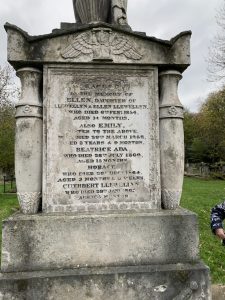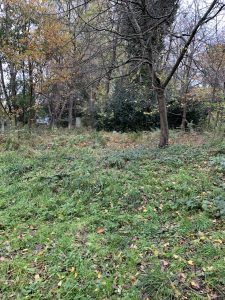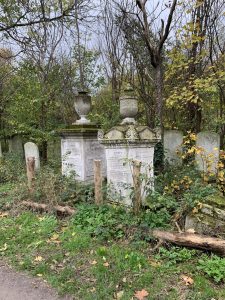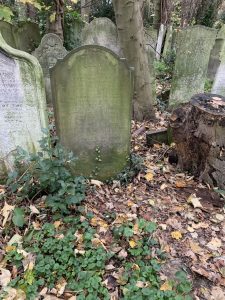TOWER HAMLETS CEMETERY PARK
An oasis of calm in a concrete jungle.
Sue Parry
It was fantastic to be able to do again the things we so took for granted prior to the pandemic!
It was The Whitechapel Society December weekend; a veritable pick-n-mix. On offer to members on the Saturday was a guided tour of Tower Hamlets Cemetery, followed by the Society’s AGM, then a two or three course meal at The Crutched Friar followed by the Society Quiz (hosted by our very own Bill Beadle). On the Sunday was the annual Christmas lunch with after-lunch speaker, Dan Smith. Members could pick the parts they wanted to attend, and a well-wrapped intrepid group met just inside the entrance to Tower Hamlets Cemetery Park just after 1pm.
A beautiful sunny but very cold day was the perfect setting for this fascinating tour. Claire Slack, heritage officer began by giving us a potted history of the park.
Now a local nature reserve and area of historic interest, this cemetery opened in 1841 and was one of the Magnificent Seven (1). These cemeteries were established in the 19th century to alleviate overcrowding in the existing churchyards as the population of London soared in Victorian times.
By 1889 247,000 bodies had been buried in this cemetery. Large numbers of the burials were in public graves which were used to bury those whose families could not afford to buy a plot. It was quite possible for several people, entirely unrelated to each other to be buried in the same grave and during our tour Claire pointed out several areas which were public graves. Families would often erect a small headstone though their position did not necessarily mark the exact spot where the loved-one had been interred.
In 1966 the ground was closed for burials and there was a plan to clear the area of graves and turn it into an open space. There was fierce opposition by the local population including a march on County Hall. The plan was shelved, and the area became neglected and overgrown. The Friends of Tower Hamlets Cemetery Park was established in 1990 and in 2000 the area was declared a Local Nature Reserve. A lot of work has been done on restoring, protecting and preserving the park’s unique history. Our own President Mark Gallow had spent some time as a member of the Friends of Tower Hamlets Cemetery Park recording inscriptions on headstones.
Then Claire then took us round this 11-acre site to see some of the graves of interest.
First stop was the Llewellyn family plot. Buried here was Dr Rees Ralph Llewellyn, whose surgery had been at 152 Whitechapel Rd and had performed the post-mortem on Mary Ann Nichols. This was a magnificent edifice with much of the inscriptions still perfectly legible.
We moved on to an area of public graves and Claire was able to point to the approximate area where Charles Lechmere was buried.
The sheer beauty and tranquility of the cemetery was very tangible. The noise of London was totally cut out with just the sound of a crow nesting in the tree-tops – it was indeed an oasis of calm in a concrete jungle.
And whilst certainly many of the graves were unmarked areas that wasn’t to say that there weren’t some quite magnificent monuments!
Whilst modest in comparison with some, one of the headstones which caught our eye was that of the Wainwright family. The Wainwright’s was headed by Henry William Wainwright. He bought plot no. 4236 in 1862 for the sum of £5 – 5 shillings. The 14-foot-deep grave was value for money as 7 members of the family were interred over the following 30 years. Henry William was the 2nd family member to occupy the grave only 18 months after his bargain purchase. One person who doesn’t feature on the internment records was his son Henry, who was found guilty of murdering Harriet Lane in 1875. He was condemned to death at the Old Bailey and was initially buried at Newgate Prison. When it closed in 1902 his body was moved with all the other murderers in the dead of night and buried in a mass grave at the City of London Cemetery in Ilford.
Another headstone marked the resting place of a character with his own place in East End history – that of Charles Jamrach, importer of exotic animals and supplier to P. T. Barnam (see Neil Watson’s articles, Oct 2020 and Dec 2020). Claire pointed out the headstone for a John Northey, and whilst the name meant nothing to us, closer inspection of stone revealed that he had died aboard The Princess Alice in 1878 (2).
There was an area which contained the graves of a number of the victims in the Bethnal Green tube disaster of 1943, the largest single loss of civilian life in WW2.
As light was fading, we reached the magnificent memorial to Esther Brown, wife of Charlie Brown who died in 1896 at the age of 36. Charlie was another East End legend: he was the publican of the Railway Tavern in Limehouse. An ex-boxer and sailor, he took over the pub in 1890 and it was a favourite haunt of sailors from all over the world. Charlie, renowned for his hospitality, was an avid collector of antiques and curiosities and should a visiting seaman be unable to pay his tab, Charlie would accept an artefact instead. These were displayed in the bar as well as in a room at the back of the pub. Both Charlie and the Railway Tavern were legendary, and on his death in 1932 it was said that in the ports of the world they will say that London will never be quite the same again.
We could all honestly say that we had never been anywhere quite like this. Tucked away, just 5 minutes’ walk from Mile End tube station – if you have never been, for aficionados of East End history, it is an absolute must! Claire is happy to guide groups of 10 or more.
The AGM beckoned, so we said our goodbyes to Claire and made our way back to Aldgate.
Our very grateful thanks to Claire and to Louise Grace who had organised this superb trip.
NOTES:
- The others being Highgate Cemetery, Nunhead, West Norwood, Kensal Green, Brompton and Abney Park.
- Elizabeth Stride claimed that she had been on the boat lost her husband and children in the disaster. There is nothing to substantiate her claim.
A short History of the Tower Hamlets Cemetery has been produced by the Friends of Tower Hamlets Cemetery www.fothcp.org/wp-content/uploads/2019/06/THCP_LEAFLET_02.pdf
The Friends of Tower Hamlets Cemetery Park useful website is www.fothcp.org/about
Llewellyn Family Plot and the area where Charles Lechmere is buried
Wainwright family plot
Tower Hamlets Cemetery Park
